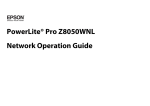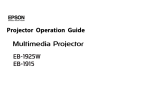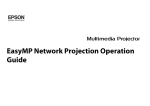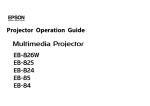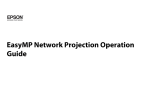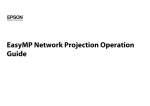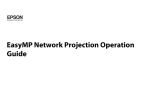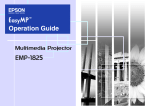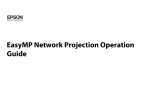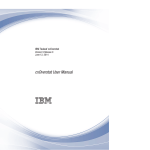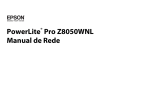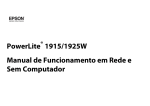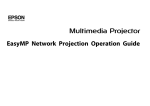Download Epson EasyMP Network Projection User`s guide
Transcript
® EasyMP Network Projection Operation Guide Contents 2 Before Use Functions and Settings for EasyMP Network Projection Functions of EasyMP Network Projection . . . . . . . . . . . . . . . . . . . . . . . 5 Projecting Only a PowerPoint Slide Show (Presentation Mode) . . 22 Sharing the Projector . . . . . . . . . . . . . . . . . . . . . . . . . . . . . . . . . . . . . . . . . . . . . . . . . . . . 5 Various Screen Transfer Functions . . . . . . . . . . . . . . . . . . . . . . . . . . . . . . . . . . . . . . . 5 Using Multi-Screen Display . . . . . . . . . . . . . . . . . . . . . . . . . . . . . . . . . . . 23 Installing the Software . . . . . . . . . . . . . . . . . . . . . . . . . . . . . . . . . . . . . . . . 6 Software Supplied. . . . . . . . . . . . . . . . . . . . . . . . . . . . . . . . . . . . . . . . . . . . . . . . . . . . . . . 6 Software Requirements. . . . . . . . . . . . . . . . . . . . . . . . . . . . . . . . . . . . . . . . . . . . . . . . . . 7 Installing . . . . . . . . . . . . . . . . . . . . . . . . . . . . . . . . . . . . . . . . . . . . . . . . . . . . . . . . . . . . . . . . 7 EasyMP Network Projection Summary Example of Adjusting the Virtual Display . . . . . . . . . . . . . . . . . . . . . . . . . . . . . . . . 24 Procedure Before Using the Multi-screen Display Function. . . . . . . . . . . . . . . 25 Setting the Virtual Display . . . . . . . . . . . . . . . . . . . . . . . . . . . . . . . . . . . . . . . . . . . . . . 25 Enable the virtual display driver (Windows only) . . . . . . . . . . . . . . . . . . . . . . 25 Adjusting the Virtual Display . . . . . . . . . . . . . . . . . . . . . . . . . . . . . . . . . . . . . . . . . 26 Allocating the Image to be Projected . . . . . . . . . . . . . . . . . . . . . . . . . . . . . . . . . . . 29 Projecting the Allocated Images . . . . . . . . . . . . . . . . . . . . . . . . . . . . . . . . . . . . . . . . 30 Connecting to a Projector on a Different Subnet. . . . . . . . . . . . . . . . 32 Advanced Connection Mode . . . . . . . . . . . . . . . . . . . . . . . . . . . . . . . . . . . . . . . . . . . 10 Quick Connection Mode (Only when the optional Wireless LAN unit is installed) . . . . . . . . . . . . . . . . . . . . . . . . . . . . . . . . . . . . . . . . . . . . . . . . . . . . . . . . . . . . . 10 Steps for Connecting . . . . . . . . . . . . . . . . . . . . . . . . . . . . . . . . . . . . . . . . . . . . . . . . . . . 10 Specifying Either an IP Address or Projector Name and Performing a Search (Advanced Connection Mode Only) . . . . . . . . . . . . . . . . . . . . . . . . . . . . 32 Performing a Search with a Profile . . . . . . . . . . . . . . . . . . . . . . . . . . . . . . . . . . . . . . 33 Making a Profile . . . . . . . . . . . . . . . . . . . . . . . . . . . . . . . . . . . . . . . . . . . . . . . . . . . . . 34 Searching by specifying a Profile . . . . . . . . . . . . . . . . . . . . . . . . . . . . . . . . . . . . . 35 Managing a Profile. . . . . . . . . . . . . . . . . . . . . . . . . . . . . . . . . . . . . . . . . . . . . . . . . . . 36 Preparing to Connect. . . . . . . . . . . . . . . . . . . . . . . . . . . . . . . . . . . . . . . . . 12 Using Set options . . . . . . . . . . . . . . . . . . . . . . . . . . . . . . . . . . . . . . . . . . . . 38 Connecting to a Projector on a Network and Projecting. . . . . . . . . 13 Setting Each Item . . . . . . . . . . . . . . . . . . . . . . . . . . . . . . . . . . . . . . . . . . . . . . . . . . . . . . 38 General settings tab . . . . . . . . . . . . . . . . . . . . . . . . . . . . . . . . . . . . . . . . . . . . . . . . . 38 Adjust performance tab . . . . . . . . . . . . . . . . . . . . . . . . . . . . . . . . . . . . . . . . . . . . . . 39 Audio Output tab . . . . . . . . . . . . . . . . . . . . . . . . . . . . . . . . . . . . . . . . . . . . . . . . . . . . 40 Two Connection Modes. . . . . . . . . . . . . . . . . . . . . . . . . . . . . . . . . . . . . . . 10 Operating the Projector . . . . . . . . . . . . . . . . . . . . . . . . . . . . . . . . . . . . . . . . . . . . . . . . 13 Operating the Computer . . . . . . . . . . . . . . . . . . . . . . . . . . . . . . . . . . . . . . . . . . . . . . . 13 Using the Connection Screen . . . . . . . . . . . . . . . . . . . . . . . . . . . . . . . . . . . . . . . . . . . 15 Using the Toolbar . . . . . . . . . . . . . . . . . . . . . . . . . . . . . . . . . . . . . . . . . . . . . . . . . . . . . . 18 3 Appendix Connection Limitations. . . . . . . . . . . . . . . . . . . . . . . . . . . . . . . . . . . . . . . 42 Supported Resolutions . . . . . . . . . . . . . . . . . . . . . . . . . . . . . . . . . . . . . . . . . . . . . . . . . 42 Display Color . . . . . . . . . . . . . . . . . . . . . . . . . . . . . . . . . . . . . . . . . . . . . . . . . . . . . . . . . . . 42 Number of Connections . . . . . . . . . . . . . . . . . . . . . . . . . . . . . . . . . . . . . . . . . . . . . . . . 42 Other Information . . . . . . . . . . . . . . . . . . . . . . . . . . . . . . . . . . . . . . . . . . . . . . . . . . . . . . 42 When Using Windows Vista or Windows 7. . . . . . . . . . . . . . . . . . . . . . . . . . . . . . . 43 Limitations when projecting from Windows Photo Gallery . . . . . . . . . . . . 43 Limitations in Windows Aero . . . . . . . . . . . . . . . . . . . . . . . . . . . . . . . . . . . . . . . . . 43 Limitations when projecting from Windows Media Center . . . . . . . . . . . . 43 Troubleshooting . . . . . . . . . . . . . . . . . . . . . . . . . . . . . . . . . . . . . . . . . . . . . 44 Problems Concerning Network Functions . . . . . . . . . . . . . . . . . . . . . . . . . . . . . . . 45 Cannot connect to the projector. . . . . . . . . . . . . . . . . . . . . . . . . . . . . . . . . . . . . . 45 When a connection is made using EasyMP Network Projection, the projected image remains as it is, and a connection cannot be made from another computer. . . . . . . . . . . . . . . . . . . . . . . . . . . . . . . . . . . . . 45 The projector is not found when EasyMP Network Projection is started. . . . . . . . . . . . . . . . . . . . . . . . . . . . . . . . . . . . . . . . . . . . . . . . . . . . . . . . . . . . . 45 Cannot connect in Advanced Connection Mode or Wired LAN connection . . . . . . . . . . . . . . . . . . . . . . . . . . . . . . . . . . . . . . . . . . . . . . . . . . . . . . . . . . 47 The Slide Show cannot be displayed on the desired display when the multi-screen display function is being executed. . . . . . . . . . . . . . . . . . . 47 Applications are no longer displayed from the computer screen when the multi-screen display function is executed. . . . . . . . . . . . . . . . . . . 47 The mouse cursor is not displayed on the computer screen. . . . . . . . . . . . 48 When connecting with EasyMP Network Projection the image is not displayed or the image is slow to appear. . . . . . . . . . . . . . . . . . . . . . . . 48 When a connection is made using EasyMP Network Projection, a PowerPoint Slide Show cannot be started. . . . . . . . . . . . . . . . . . . . . . . . . . . 48 When a connection has been made using EasyMP Network Projection, the screen will not be refreshed when using an Office application.. . . . . . . . . . . . . . . . . . . . . . . . . . . . . . . . . . . . . . . . . . . . . . . . . . . . . . . . . . 49 Error message when starting up EasyMP Network Projection . . . . . . . . . . 49 Network settings are not restored after cutting the connection to the computer with EasyMP Network Projection. . . . . . . . . . . . . . . . . . . . . 50 Glossary . . . . . . . . . . . . . . . . . . . . . . . . . . . . . . . . . . . . . . . . . . . . . . . . . . . . . 51 Notices . . . . . . . . . . . . . . . . . . . . . . . . . . . . . . . . . . . . . . . . . . . . . . . . . . . . . . 52 Copyright Notice . . . . . . . . . . . . . . . . . . . . . . . . . . . . . . . . . . . . . . . . . . . . . . . . . . . . . . . 52 About Notations . . . . . . . . . . . . . . . . . . . . . . . . . . . . . . . . . . . . . . . . . . . . . . . . . . . . . . . 52 Trademarks . . . . . . . . . . . . . . . . . . . . . . . . . . . . . . . . . . . . . . . . . . . . . . . . . . . . . . . . . . . . 52 4 Before Use This guide describes useful functions for EasyMP Network Projection and how to install the software. Functions of EasyMP Network Projection Functions of EasyMP Network Projection You can use EasyMP Network Projection to display your computer screen from the projector via a network. Sharing the projector over the network and using various screen transfer functions allow you to hold effective meetings and presentations Sharing the Projector If the projector is connected to a network, you can share the projector from computers on the network. When projecting data from different computers during a meeting or presentation, you can progress smoothly without changing the signal cable between each computer. Even the distance between the projector and the computer does not cause any problems. 5 Various Screen Transfer Functions You can use the following screen transfer functions. • Presentation Mode s p.22 This function can project a PowerPoint Slide Show running on a computer. You can give stylish presentations by projecting a black screen while making preparations, for example, and when not performing a Slide Show. • Distribution function The screen being displayed by a remote computer can be simultaneously displayed by up to four projectors on the same network. • Switching function By using the meeting switching function, if EasyMP Network Projection is installed on all of the computers, the presenters can take turns projecting their own images without changing cables. Installing the Software Installing the Software You can find the software on the supplied "EPSON Projector Software for Meeting & Monitoring" CD-ROM. Install the software on the computer you are using. Software Supplied You can find the following software on the "EPSON Projector Software for Meeting & Monitoring" CD-ROM. • EasyMP Network Projection Software for sending computer screen images to a projector via a network connection. • EasyMP Monitor Software that lists the current status of Epson projectors connected to the network, and monitors and controls those projectors. You can collectively manage multiple projectors by using EasyMP Monitor. For details on using EasyMP Monitor, see the "EasyMP Monitor Operation Guide". 6 Installing the Software Software Requirements 7 Display Display color of 16-bit color or greater (approx. 32,000 display colors) EasyMP Network Projection runs on computers that meet the following requirements. OS Windows series (32-bit versions only) • Windows 2000 (Service Pack 4) Resolution of no less than XGA (1024x768) and no higher than UXGA (1600x1200) * Operation is not guaranteed in Mac OS X 10.5.0 because the Firewall settings are not set correctly when the version is updated. • Windows XP • Windows XP (Service Pack 1 or later) • Windows Vista • Windows Vista (Service Pack 1 or later) • Windows 7 Mac OS X series • Mac OS X 10.3.x Installing Make sure you check the following points before starting installation. • When using a computer running any of the following operating systems, you must have administrator authority to install EasyMP Network Projection. • Mac OS X 10.4.x • Mac OS X 10.5.1 or later* • Mac OS X 10.6.x Recommended: Mac OS X 10.3.9/10.4.11/10.5.5 CPU Mobile Pentium III 1.2GHz or faster Power PC G3 900MHz or faster Recommended: Pentium M 1.6GHz or faster CoreDuo 1.5GHz or faster Amount of Memory 256MB or more Hard Disk Free Space • Windows 2000 • Windows XP • Windows Vista • Windows 7 • Make sure that you close all running applications before starting installation. • When the language selected for the installation varies from that of the OS being used, the screens may not be displayed correctly. q For EMP NS Connection users The EMP NS Connection name has changed. Before change: EMP NS Connection Recommended: 512MB or more After change: EasyMP Network Projection 20MB or more When using the same function as EMP NS Connection on the projector, install EasyMP Network Projection after uninstalling EMP NS Connection. You cannot connect to the projector correctly using EMP NS Connection. Installing the Software Procedure 8 B Insert the "EPSON Projector Software for Meeting & Monitoring" CD-ROM into the computer. For Windows A B C D E F G Turn on your computer. Insert the "EPSON Projector Software for Meeting & Monitoring" CD-ROM into the computer. The installer starts automatically. Click "Easy Install". To select the software you want to install, select Custom Install. To change the sofrware display language, click Language. Select the applications you want to install, and then click "Install". window. Installation starts. D Click "Exit" to complete the installation. q • If installation does not start automatically (Windows only), select Start Run, and in the Run dialog box, type the letter for your CD-ROM drive followed by :\EPsetup.exe and then click OK. • Uninstalling: For Windows Select Start - Settings - Control Panel - Add-Remove Programs or Add or Remove Programs and then remove EasyMP Network Projection. For Mac OS When the License Agreement screen is displayed, click "Yes". When the Add-Remove EPSON Virtual Display screen is displayed, click "OK". To use Multi-screen display you need to set up EPSON Virtual Display. If you do not want to set it now, you can do so later. s p.24 Click "Exit" to complete the installation. For Mac OS A C Double-click the "ENPvx.xx_Installer" icon in the EPSON Turn on your computer. From Applications, delete the EasyMP Network Projection folder. 9 EasyMP Network Projection Summary This chapter explains how to connect the computer and the projector via a network, and the procedure for displaying images from your computer's screen with the projector. Two Connection Modes Two Connection Modes There are two methods of connecting a computer and the projector via a network by using EasyMP Network Projection. Advanced Connection Mode Advanced Connection Mode is an infrastructure connection, and connects to an existing network system via a network cable. When connecting to a network via Wired LAN, connect the projector to the network hub with a commercially available LAN cable. If you install the optional Wireless LAN unit in the projector, you can connect to the network via a wireless LAN access point. 10 Quick Connection Mode (Only when the optional Wireless LAN unit is installed) Quick Connection Mode is only available when you install the optional Wireless LAN unit in the projector. Quick Connection Mode temporarily assigns the projector's SSID to a computer creating an ad hoc connection, and restores the computer's network settings after disconnecting.s p.12 • You can easily connect to a computer and project images from the computer without making network settings. • This lets you connect easily without a connector cable, and you can even connect if the projector and the computer are at remote locations. Steps for Connecting Use the following steps to connect the computer to the projector and project in EasyMP Network Projection. Two Connection Modes You need to perform steps 1 to 4 only the first time you connect. 1. Install EasyMP Network Projection on the computer to be connected. s p.7 2.* Make network settings on the computer and put it into network connection status. s p.12 3. For Quick Connection Mode: Install the optional Wireless LAN unit in the projector (if already installed, go to step 5). For Advanced Connection Mode: Enable the Wired LAN or Wireless LAN adapter in "Port Configurations". s Computer's documentation 4. Make network settings on the projector and put it into network connection status. See your projector User’s Guide. 5. Start EasyMP Network Projection on the computer and connect with the projector. s p.13 * When the computer you are using is normally connected to the network, you do not need to make network settings on the computer. 11 Preparing to Connect Preparing to Connect Use the following procedure to set up the computer for connection. For Windows Make network settings for the computer by using the utility software supplied with the LAN adapter. For more information on the utility software, see the manual supplied with your LAN adapter. For example, as shown in the following illustration, when a red cross (^) is displayed over the network icon on the taskbar, you cannot connect to the projector. For Mac OS Set the network port and communication status. For more details on setting the communication status, see the manual for your computer or the AirPort card. 12 Connecting to a Projector on a Network and Projecting Connecting to a Projector on a Network and Projecting Operating the Projector Before connecting, put the projector into connection standby status. Make sure the projector network settings are complete, and the projector is connected to network equipment such as a network hub via a commercially available network cable. 13 B Press the LAN button on the Remote Control. The LAN standby screen is displayed. If there is no signal for the current input source, it automatically switches to the LAN source. If it does not automatically switch to the LAN source, press the LAN button. Procedure A Press the [t] button on the remote control to turn the power on. Operating the Computer In the following explanations, unless otherwise noted, Windows screen shots are used. Similar screens are also displayed for Mac OS. Connecting to a Projector on a Network and Projecting Procedure A 14 D When Projector Keyword is set to "On" from the projector, the Keyword entry screen is displayed. Enter the keyword displayed on the LAN standby screen, and then click "OK". When the connection is complete, the computer screen is projected. The following EasyMP Network Projection toolbar is displayed on the computer screen. You can use this toolbar to operate the projector and make settings, and to disconnect the network connection. For details on the toolbar, see "Using the Toolbar". s p.18 Start EasyMP Network Projection. For Windows Select Start - Programs (or All Programs) - EPSON Projector EasyMP Network Projection - EasyMP Network Projection V2.XX. For Mac OS Double-click the Applications folder of the hard drive volume in which EasyMP Network Projection is installed, and then double-click the EasyMP Network Projection icon. B Select "Quick Connection Mode" (only available when the optional Wireless LAN unit is installed) or "Advanced Connection Mode", and then click "OK". The projector search results are displayed. To always connect using Advanced Connection Mode, select Set the selected Connection Mode as the default mode for future connections. C Select the projector you want to connect to, and then click "Connect". If the projector you want to connect to is not displayed in the search results, click the Automatic search button. The search takes about 30 seconds. For details on the connection screen, see "Using the Connection Screen". s p.15 q When connecting from another computer, such as when changing presenters, start EasyMP Network Projection from the computer you want to connect. The computer that is currently connected is disconnected, and the projector is then connected with the computer that is trying to connect now. If a connection is made while Disable interrupt connection is set, the connection is not switched to another computer. Connecting to a Projector on a Network and Projecting 15 When the system starts in Quick Connection Mode. Using the Connection Screen Start EasyMP Network Projection to display the following screen. The operation of each button or item is described in the following table. When the system starts in Advanced Connection Mode. 1 Automatic search In Advanced Connection Mode, you can search for available projectors on the network system to which the computer is connected. In Quick Connection Mode, you can search for the projector based on the SSID. 2 Manual search In Advanced Connection Mode, you can search for a projector based on a specified IP address or projector name. In Quick Connection Mode, you can search for the projector based on the SSID selected from a list. Connecting to a Projector on a Network and Projecting 3 Status 7 The following six icons indicate the status of the detected projectors. Standby Select for connecting. Busy Select for connecting. When you click Connect, the computer currently connected is disconnected and your computer is connected. 4 8 Currently in use by another application The projector's Configuration Menu is open. You can select it after closing the Configuration menu and running the search again. 10 Searching Displayed while running Manual search or Profile. Projector name 6 Use multi-display Check the box to use the Multi-screen display function. When this is selected, Display layout and Display properties are displayed at the bottom of the screen.s p.24 Save in the profile Saves the results of a network projector search as a Profile.s p.33 11 Clear list Deletes all search results. 12 IP address (Advanced Connection Mode only) The projector's IP address is displayed. 13 Display (Select the number displayed (when Use multi-display is selected). s p.30 14 Profile You can search for a projector on the network using a Profile saved using Save in the profile. s p.33 Disable interrupt connection Check the box to prevent an interrupt connection by other computers while connected to the selected projector. Set options You can set general setting options such as the processing method when starting EasyMP Network Projection. For details, see Set options s p.38 The projector's name is displayed. 5 Connect Connect to the projector you selected from the search results list. When a connection is made with a projector, a toolbar is displayed. 9 Displayed when a projector cannot be found as a result of Manual search or Profile. In Quick Connection Mode, you can only select multiple projectors with the same SSID. Troubleshooting If there is a problem and you cannot make a connection, press this button to open the EasyMP Network Projection Troubleshooting screen. Busy (Disable Cannot be selected. Disable interrupt interrupt connection is set on connection) another computer which is already connected. Not found. 16 15 SSID (Quick Connection Mode only) The projector's SSID is displayed. 16 Signal intensity This is displayed when the connection is made in Quick Connection Mode. As the Signal intensity increases, so does the number of lit indicators. Connecting to a Projector on a Network and Projecting 17 Update list (Quick Connection Mode only) Updates Status and Signal intensity. 17 Connecting to a Projector on a Network and Projecting Using the Toolbar The toolbar is displayed on the computer screen after EasyMP Network Projection starts and a connection is made with the projector. You can use this toolbar to operate and make settings for the projector. 18 Select target projector Click to limit the projectors operated from the toolbar when projecting from multiple projectors using the distribution function or Multi-screen display. The indication below the icon shows the projectors that can be controlled. ALL indicates that all of the connected projectors can be controlled. For example, when "1, 3" is displayed, projectors No. 1 and No. 3 can be controlled. Click to display the following screen. 1 Select the projector to be controlled. 2 Indicates the No. of an allocated projector. This No. indicates the No. of the projector that you can control from the toolbar. 3 Indicates the status of the projector. Stop Stops projection while connected to the projector. A black screen is projected while stopped. Audio does not stop. To stop the audio, or to display a User's Logo while projection is stopped, use the A/V Mute function. Connecting to a Projector on a Network and Projecting 19 Show Projector control Releases Stop or Pause. While the projector is connected to the network, the projector's A/V Mute, Switch PC source and Switch video source functions can be controlled from both the Remote Control and the projector's Control panel. Pause Pauses projected images while connecting to the projector. The audio is not paused. Presentation Mode Click to display the following toolbar. Each time this is clicked, Presentation Mode switches between enabled/disabled. s p.22 A/V Mute The same function as the A/V Mute button on the Remote Control. See your projector User’s Guide. Switch PC source The Source alternates between Computer1, Computer2, USB Display, USB, and LAN each time you click. Switch video source The Source alternates between S-Video and Video each time you click. S-Video does not switch if the cable is not connected. Connecting to a Projector on a Network and Projecting 20 Screen Preview Switch toolbar display Displays the multi-screen preview screen. The toolbar display is switched as follows. The toolbar display remains as is until switched again. Click to display a preview with the settings you have made. Click each display to enlarge each Screen Preview to full-screen. Full Normal Set options Transmission performance during the transfer of computer images can be adjusted.s p.38 Movie Sending Mode Not enabled on this projector. The message "The connected projectors do not support Movie Sending." is displayed. Disconnect Disconnects the connection to the projector. Signal intensity This is displayed when a connection is made in Quick Connection Mode. As the Signal intensity increases, so does the number of lit indicators. Simple 21 Functions and Settings for EasyMP Network Projection This chapter explains the functions that may be useful in a meeting or presentation, such as the Multi-Screen Display which allows you to send images to multiple projectors from a single computer. Projecting Only a PowerPoint Slide Show (Presentation Mode) Projecting Only a PowerPoint Slide Show (Presentation Mode) In Presentation Mode, the images are only displayed when performing a PowerPoint Slide Show on a computer. When you stop Slide Show, the projector displays a black screen. This is useful when you only want to display the Slide Show. In addition to PowerPoint, Keynote is compatible with Presentation Mode for Mac OS. Procedure A B C If necessary, select another projector to be controlled.s p.18 Click the button on the toolbar. Presentation Mode begins. Click the button again to exit Presentation Mode. 22 Using Multi-Screen Display Using Multi-Screen Display 23 Using Multi-Screen Display Example of Adjusting the Virtual Display 24 Arrangement example 2 By arranging the virtual display allocation, you can project only the image that you want to show or project different images from left to right in a presentation. Arrangement example 1 1 2 1 2 Actual monitor image PowerPoint file Image of virtual display Excel file Actual monitor image PowerPoint file presenter tools Image of virtual display Slide Show using a PowerPoint file Using Multi-Screen Display Procedure Before Using the Multi-screen Display Function 1. Setting the Virtual Display s p.25 In a Windows environment, enable the virtual display driver as necessary. Also, for both Windows and Mac OS, set up the virtual display arrangement. 2. Allocating the image to be projected s p.29 Open the file to be projected, and then move the screen to the virtual display according to the actual projection arrangement. 3. Projecting the allocated images s p.30 Allocate a virtual display number to a projector that is connected through the network, and then start projection. 25 Procedure A Start Windows on the computer, and then select "Start" - "Programs" (or "All Programs") - "EPSON Projector" "EasyMP Network Projection" - "Add-Remove EPSON Virtual Display". The Add-Remove EPSON Virtual Display screen is displayed. B Select the virtual display you want to use. Up to four monitors can be added. In this example, a single virtual display is to be used. When setting multiple virtual displays, select as many displays as is necessary. Any one of the displays can be selected. C Click "OK". Setting the Virtual Display This chapter explains the virtual display for arrangement example 1. s p.24 Enable the virtual display driver (Windows only) Enable the virtual display driver. Those users listed below do not have to perform this operation. Go to procedure s "Adjusting the Virtual Display" p.26. • Those users who have enabled virtual displays installing EasyMP Network Projection. • For Mac OS users. When you click OK, the drivers for the virtual display are enabled. At this point, it is normal for the display to flicker. Wait for the Add-Remove EPSON Virtual Display screen to close. Using Multi-Screen Display Adjusting the Virtual Display 26 B Select the "Use multi-display" checkbox. After starting EasyMP Network Projection, the procedure for setting up the virtual displays differs for Windows and Mac OS. The procedures are explained separately below. q Check the following points before starting EasyMP Network Projection when connecting via Wireless LAN. If the following points are not set correctly, Multi-screen display cannot be used. • The SSID for the computer and each projector must be the same. • The wireless LAN system for the computer and each projector must be the same. You can modify the SSID and Wireless LAN system for the projector from the Network menu in the projector's Configuration menu. See your projector User’s Guide. Procedure For Windows A Select "Start" - "Programs" (or "All Programs") - "EPSON Projector" - "EasyMP Network Projection" - "EasyMP Network Projection V2.XX" to start EasyMP Network Projection. Display layout and Display properties are added at the bottom of the screen. Using Multi-Screen Display C Click "Display properties". 27 E Drag the displayed monitor icon and place it where desired. Here, the actual monitor (1) is placed on the left, while the virtual monitor (3) is placed on the right. When the computer has multiple display output terminals, the numbers assigned to the virtual terminals will be sequential to those of the physical terminals. The Display properties screen is displayed. D Click the "Settings" tab. q • When an external monitor is connected as a secondary monitor, the image for that screen cannot be projected. • Depending on the hardware, the number of the secondary monitor may be other than "2". When the monitor icon is displayed on the screen, click the icon and confirm that the monitor type shown under "Display" is other than "secondary". Using Multi-Screen Display • For the Screen Resolution settings, see the following.s p.42 28 B Select the "Use multi-display" checkbox. When the monitor icon is arranged, a virtual display is connected as in the image below. F Click the "OK" button to close the Display properties screen. At this point, the virtual display layout has been fixed. Allocate the projecting images next. s p.29 For Mac OS A Display layout and Display preferences are added at the bottom of the screen. C Click "Display preferences". Start EasyMP Network Projection. Double-click the Applications folder of the hard drive volume in which EasyMP Network Projection is installed, and then double-click the EasyMP Network Projection icon. In this example, we select and start in Advanced Connection Mode. The display setting screen is displayed. Using Multi-Screen Display 29 D Click "Arrangement". F Drag the displayed monitor icon and place it where desired. E Clear "Mirror Displays". G Close the display setting screen. At this point, the screen layout has been fixed. Allocating the Image to be Projected This section explains the virtual display for arrangement example 1. s p.24 Procedure A Open the file to be projected. Start the PowerPoint and Excel files. Using Multi-Screen Display B Drag the window to the desired virtual display monitor, and allocate it where the image is to be projected. Drag the Excel window to the right until it cannot be seen. As a result, the PowerPoint window appears on the actual monitor, while the Excel window appears on the virtual display on the right. Projecting the Allocated Images This section explains the virtual display for arrangement example 1. s p.24 Procedure A Select the number of the virtual display you want to from "Display", and set which image to be projected from which projector. 30 Using Multi-Screen Display B 31 In a Windows environment, you cannot view the image being sent to a virtual display on the computer. To adjust the image on the virtual display, you must do so while viewing the projected image. To perform mouse-based operations on the virtual display, move the mouse pointer in the direction of the virtual display, so that the pointer appears on the virtual display. Click "Connect". C To terminate multi-screen display, click "Disconnect" on the toolbar. q The image allocated to each projector is projected. In a Windows environment, if the virtual display driver has been enabled so that the mouse pointer can be moved outside the limits of the screen, there may be occasions when you lose track of the location of the pointer. If you are not using a virtual display, clear the virtual display checkbox on the Add-Remove EPSON Virtual Display screen so that the mouse pointer moves back inside the screen's display area. To subsequently use multi-display again, select the required display under Add-Remove EPSON Virtual Display. To clear a check mark, see the following.s p.25 Connecting to a Projector on a Different Subnet Connecting to a Projector on a Different Subnet This chapter explains how to connect a computer to a projector on a different sub-net via a Wired LAN or a wireless LAN access point on an existing network system. By default, this application only searches for projectors on the same subnet as the computer. Therefore, even if you perform a search for projectors on the network, projectors on a different subnet will not be found. You can, however, identify and connect to a projector on a different subnet as follows: • Specify either an IP address or Projector name and perform a search. The IP Address can be input directly. Also, provided the Projector name to be connected has been registered on the DNS server, you can perform a search simply by inputting that Projector name.s p.32 • Performing a search based on a Profile Once you have performed a search for a projector on a different subnet by specifying either an IP Address or a Projector name, you can save the search as a Profile with an easy-to-remember name, and then use that Profile whenever you subsequently want to search for a projector on a different subnet.s p.33 q • If a search fails to find a projector, the most likely causes are as follows. Proceed as appropriate, depending on the cause of the failure. For both Windows and Mac OS: If there is no wireless LAN signal or if the signal is weak, check whether there is anything that could be interfering with the signal. When the optional Wireless LAN unit is installed in the projector, and connecting Mac OS to a wireless LAN, check whether AirPort is set to On. Or, check whether an appropriate access point has been selected. • When you use Manual search in Quick Connection Mode, you can specify the SSID. When there are a lot of projectors you can narrow the search field by using SSID. 32 Specifying Either an IP Address or Projector Name and Performing a Search (Advanced Connection Mode Only) In the following explanations, unless otherwise noted, Windows screen shots are used. Similar screens are also displayed for Mac OS. Procedure A Click "Manual search" on the EasyMP Network Projection projector selection screen. Connecting to a Projector on a Different Subnet B Enter the IP address or the projector name for the projector you want to connect to, and click "OK". 33 Performing a Search with a Profile You can save a search for a frequently used projector as a Profile. A "Profile" is a file containing all of the information pertaining to a given projector, such as the projector name, its IP address, and SSID. If you specify that information, the next time you perform a search, there will be no need to specify the IP address or projector name when you search. For example, by creating a group of Profiles for each place where a projector is setup and managing them with folders, the target projector can be found quickly. The search results are displayed on the EasyMP Network Projection projector selection screen. Provided the target projector has been identified, select that projector, and then click Connect to establish a connection. When you will always be using that projector, save the search as a Profile, so that you do not have to specify the relevant details every time you perform a search. s p.34 1 Building A 5 Floor 1 2 Building B 6 Floor 2 3 Building C 7 Floor 3 4 Building D This section explains how to create and edit a Profile. Connecting to a Projector on a Different Subnet Making a Profile Profiles are made by saving search results. For details on how to edit a previously saved Profile, see the following section. s p.36 Procedure A While the projector is displayed on the EasyMP Network Projection projector selection screen, click "Save in the profile". The Save in the profile screen is displayed. 34 Connecting to a Projector on a Different Subnet B 35 Enter a Profile name, and then click "Add". Projector information is registered in the Profile. If you have previously saved a Profile, you are prompted to confirm whether or not to overwrite. To save a Profile with a different name, select Save as. If you have created a folder for a Profile, the following screens are displayed. After entering the Profile name and selecting the Save in destination, click Add. For Mac OS q For details on how to create a folder for a Profile, see the following section. s p.36 Searching by specifying a Profile You can search by specifying the Profile you created. For Windows Connecting to a Projector on a Different Subnet Procedure A Click "Profile" on the EasyMP Network Projection projector selection screen. If no Profile is registered, you cannot select Profile. 36 Managing a Profile You can change the name and the hierarchical structure of the Profile. Procedure A Click "Set options" on the EasyMP Network Projection main screen. The Set options screen is displayed. B Click "Edit profile". B From the menu that is displayed, select the projector you want to connect to. The Edit profile screen is displayed. The search results are displayed on the EasyMP Network Projection projector selection screen. Provided the target projector has been identified, select that projector, and then click Connect to establish a connection. Connecting to a Projector on a Different Subnet C Edit the contents registered in the Profile. 37 Profile Item Function Copy You can copy the Profile. The copied Profile is saved in the same folder as the original with the same name. Delete You can delete the Profile and the folder. Rename Displays the Rename dialog box allowing you to rename the folder or the Profile. You can enter up to 32 characters in the Rename dialog box. Create folder You can create a new folder. Export Exports a created Profile allowing you to import and use that Profile. Import Used when you want to read and use an exported Profile. Information on selected profile Item 1 :Indicates a folder. 2 :Indicates a Profile. Profile Projector name, IP address You can display the projector information registered in the Profile. Delete You can delete the information for the selected projector. When all projector information is deleted, the profile is also deleted. D Click "OK". Profile Item Function Function You can display the registered Profile. You can manage it by creating a folder. You can change the order of the Profile or the folder by dragging & dropping. Saves your edits and closes the Edit profile screen. Using Set options Using Set options You can make setting options such as the processing method when EasyMP Network Projection starts. Access Set options from the EasyMP Network Projection main screen. 38 Setting Each Item Set each item from the General settings tab and the Adjust performance tab. Procedure A Click "Set options" on the EasyMP Network Projection main screen. General settings tab Use full-screen video transfer The Set options screen is displayed. B Set each of the items. Confirm the details of the set items in the next step. When you have made all the necessary settings, click OK to close the Set options screen. This setting is disabled because the projector does not support the movie sending function. Encrypt communications Select to Encrypt and transmit data. Even if data is intercepted, it cannot be decrypted. When using Quick Connection Mode, make sure you always select this checkbox. Using Set options Display Connection Mode Selection window on startup 39 Set whether or not the Quick Connection Mode/Advanced Connection Mode screen is displayed when EasyMP Network Projection starts. Adjust performance tab Clear this checkbox once you have settled on a regular startup method. Search method on startup Select from the following projector search methods executed when EasyMP Network Projection is started. Automatic search on startup Specify search method after startup Search with the last network configuration Edit profile The Edit profile dialog box is displayed.s p.36 Switch LAN Windows only The Switch Network Adapter dialog box is displayed. This is used when it is necessary to switch the network adapter to be used for a search when a computer has multiple adapters. By default, all of the network adapters are used to perform a search. When a Wired LAN is always used as the connection method, select a Wired LAN adapter. Restore Defaults You can reset all adjustment values on the General settings tab to their default settings, except for Edit profile and Switch LAN. Performance adjustment slider The performance can be set to Fast, Normal, and Fine. Set to Fast when movie projections are interrupted. Transfer layered window Windows only (excluding Windows Vista and Windows 7) Set whether or not to transfer a layered window. The layered window is in use when contents such as messages displayed on the computer are not projected by the projector. Select this checkbox to project contents such as messages that use the layered window. Clear this checkbox if you do not want the mouse pointer to flicker on the screen. Using Set options Restore Defaults q When you click displayed. 40 You can reset all adjustment values for the Adjust performance tab to their default settings. on the toolbar, only the Adjust performance tab is Audio Output tab Because this projector does not support the audio sending function, settings on the Audio Output tab are disabled. 41 Appendix Connection Limitations Connection Limitations When projecting computer images while running EasyMP Network Projection, the following restrictions apply. Confirm these points. 42 Display Color The number of colors for computer screens that can be projected. Windows Supported Resolutions The following computer screen resolutions can be projected. You cannot connect to a computer with a resolution greater than UXGAg. • VGA g(640x480) • SVGA g(800x600)* • XGA g(1024x768)* • SXGA g(1280x960) • SXGA (1280x1024)* • SXGA+ (1400x1050)* • WXGA (1280x768) • WXGA (1280x800) • WXGA+ (1440x900) • UXGA (1600x1200) * Supported resolutions when multi-screen display function is on. If a computer with a special screen size is used where the ratio of height and width is not represented, a screen resolution closest to the width is selected from the list of 10 above. In this case, in wide screen the horizontal margins are projected, in narrow screen the empty vertical margins are black. Mac OS 16-bit color About 32,000 colors (16-bit) 32-bit color About 16.7 million colors (32-bit) The operational guarantee for multi-screen display is 16-bit and 32-bit color. Number of Connections You can connect up to four projectors to one computer and project simultaneously. You cannot connect multiple computers to one projector simultaneously. Other Information • If the transmission speed of the Wireless LAN is low, the network might be cut off unexpectedly. • Audio is not transmitted. • When videos are played back, they do not play back as smoothly as when displayed on the computer. • Applications that use part of DirectX functions may not be displayed correctly (Windows only). • Cannot project full screen MS-DOS prompts (Windows only). Connection Limitations • There are times when the image on the computer screen and the image projected by the projector may not match exactly. When Using Windows Vista or Windows 7 Note the following points when using EasyMP Network Projection on a computer running Windows Vista or Windows 7. Limitations when projecting from Windows Photo Gallery 43 • The layered window is projected regardless of the setting for Transfer layered window within Set options in EasyMP Network Projection. For example, when the Transfer layered window setting for EasyMP Network Projection toolbar is disabled, it is not projected even if it is displayed on the computer screen. • A few minutes after you connect a computer to the projector over a network with EasyMP Network Projection, the following message is displayed. It is recommended that you select "Keep the current color scheme, and don't show this message again". This selection is enabled until the computer is restarted. Note the following two limitations when launching Windows Photo Gallery when EasyMP Network Projection is running. • Slide Show is played back in simple mode when projecting from Windows Photo Gallery. • Because the toolbar is not displayed, you cannot make changes while playing a Theme (effects), regardless of the Windows Experience Index rating. • Once simple mode has started, you cannot change modes while Windows Photo Gallery is running even if you close EasyMP Network Projection. Restart Windows Photo Gallery. • You cannot play movies. Limitations when projecting from Windows Media Center Limitations in Windows Aero Note the following two limitations when the window design for your computer is Windows Aero. You cannot project images in full screen display using Windows Media Center. Switch to the window display mode to project the images. * Similarly, images cannot be projected with Quick Wireless Connection or USB Display. Troubleshooting Troubleshooting If any of the following problems occur, refer to the pages given for each problem. Problems concerning network functions "Cannot connect to the projector." s p.45 "When a connection is made using EasyMP Network Projection, the projected image remains as it is, and a connection cannot be made from another computer." s p.45 "The projector is not found when EasyMP Network Projection is started." s p.45 "Cannot connect in Advanced Connection Mode or Wired LAN connection" s p.47 "The Slide Show cannot be displayed on the desired display when the multi-screen display function is being executed." s p.47 "Applications are no longer displayed from the computer screen when the multi-screen display function is executed." s p.47 "The mouse cursor is not displayed on the computer screen." s p.48 "When connecting with EasyMP Network Projection the image is not displayed or the image is slow to appear." s p.48 "When a connection is made using EasyMP Network Projection, a PowerPoint Slide Show cannot be started." s p.48 "When a connection has been made using EasyMP Network Projection, the screen will not be refreshed when using an Office application." s p.49 "Error message when starting up EasyMP Network Projection" s p.49 "Network settings are not restored after cutting the connection to the computer with EasyMP Network Projection." s p.50 44 Troubleshooting 45 Problems Concerning Network Functions Cannot connect to the projector. Check the message on the screen and then apply the following countermeasures. Error Messages The application version used is not supported. Install the latest version of the application on your computer. Remedy Install EasyMP Network Projection from the EPSON Projector Software for Meeting & Monitoring CD-ROM supplied with the projector. When a connection is made using EasyMP Network Projection, the projected image remains as it is, and a connection cannot be made from another computer. Check Did the presenter leave the conference room without cutting off the network connection? Remedy With EasyMP Network Projection, the connection with the computer that was previously connected can be cut off when another computer tries to connect with the projector, and it connects with the computer that is trying to connect. Therefore, when a Projector Keyword is not set for the projector, or if you know the Projector Keyword, you can cut off the current connection. Then you can perform a connection operation to connect to the projector. When a Projector Keyword is set for the projector but you do not know the Projector Keyword, restart the projector and reconnect. The projector is not found when EasyMP Network Projection is started. Check Is the Wireless LAN unit connected? For Wireless LAN Remedy Check that the optional Wireless LAN unit is securely connected. Troubleshooting 46 Check Is the Network Configuration screen from the Configuration menu displayed on the projector? Remedy When the Network Configuration screen is displayed on the projector, network connection for EasyMP Network Projection is disabled. Close network settings on the projector and return to the LAN standby screen. Are the computer's LAN card and the built-in LAN function Check that LAN is valid by checking Control Panel - System - Hardware in the device manager. available? Is the SSID the same as that of the access point? Set an SSID that is different from that of the access point. See your projector User’s Guide. Quick Connection Mode Is the DHCP function for Wired LAN turned On? Quick Connection Mode Turn Off the DHCP setting for Wired LAN from the Configuration Menu. See your projector User’s Guide. Was the network adapter used selected correctly with EasyMP Network Projection? If the computer has multiple LAN environments, it cannot connect unless the network adapter is selected correctly. When using a computer running Windows, start EasyMP Network Projection and select the network adapter you are using from Set options - Switch LAN.s p.38 For Wireless LAN connection, is the Wireless LAN setting enabled when the computer is in power save mode? Enable the Wireless LAN. Are there any obstacles between the access point and the Sometimes electromagnetic interference prevents the projector from being found in a search. Check for any obstacles between the access point and the computer or projector, and change their position. computer or projector? For Wireless LAN Is the computer's Wireless LAN electromagnetic wave set Set the electromagnetic wave strength to maximum. too low? Does the Wireless LAN conform to 802.11g, 802.11b, or 802.11a? It is only compatible with standards 802.11g, 802.11b, and 802.11a, and not with other standards such as 802.11. Is the firewall turned off, or has the firewall been registered as an exception? When you do not wish to turn off the firewall or register the firewall as an exception, make the necessary settings to open the ports. The ports used by EasyMP Network Projection are "3620", "3621", and "3629". Is the network cable connected correctly? For Wired LAN Check that the network cable is connected correctly. Reconnect it if it is not connected or not connected properly. Troubleshooting 47 Cannot connect in Advanced Connection Mode or Wired LAN connection Check Remedy Is the SSID setting different. Set the computer, the access point, and the projector to the same SSID. See your computer, router, and projector manuals. Is the same WEP key set? When selecting WEP from Security, set the access point, the computer, and the projector to the same WEP key. See your computer, router, and projector manuals. Are the connection denial functions, such as MAC Set the projector to allow connections from the access point. Addressg restrictions and port restrictions, set correctly at the access point? Are the IP address, the Subnet Mask, and the Gateway Address for the access point and the projector set correctly? When not using a DHCP, adjust each setting. See your projector User’s Guide. Are the access point and the projector's subnet different? Select Manual search from EasyMP Network Projection, specify the IP address, and connect. s p.32 The Slide Show cannot be displayed on the desired display when the multi-screen display function is being executed. Check Are you using PowerPoint 2002 or an earlier version? For Windows Remedy To set up and use two or more virtual displaysg, use PowerPoint 2003 or later, or limit the number of virtual displays to one before displaying the Slide Show. Applications are no longer displayed from the computer screen when the multi-screen display function is executed. Check Is another application running on the virtual displayg? For Windows Remedy When EPSON Virtual Display is installed, another application sometimes runs on the virtual display. In this case, set EPSON Virtual Display to "Off" in "Screen properties". Troubleshooting 48 The mouse cursor is not displayed on the computer screen. Check Is EPSON Virtual Display installed? For Windows Remedy The mouse cursor was moved onto the virtual displayg. When the virtual display checkbox is cleared on the Add-Remove EPSON Virtual Display screen, the mouse pointer returns to the screen display area. When connecting with EasyMP Network Projection the image is not displayed or the image is slow to appear. Check Remedy Did you try to play back movies with Media Player or try to Depending on the computer, the movie playback screen in Media Player may not be displayed, and operate the screen saver preview? the screen saver preview may not be displayed normally. Is WEP encryption effective, or are multiple projectors connected? The display speed decreases when WEP encryption is effective or multiple projectors are connected. Have you enabled DHCP? When DHCP is set to On in Advanced Connection Mode, if an available DHCP server is not found, it may take some time to enter LAN standby status. Is Wireless LAN 802.11g/b being used in Quick Connection Depending on the electromagnetic wave environment, there are times when the image and sound Mode? for movies may stop. When using the movie sending function, use Advanced Connection Mode or Wireless LAN 802.11a in Quick Connection Mode. When a connection is made using EasyMP Network Projection, a PowerPoint Slide Show cannot be started. Check Remedy Was EasyMP Network Projection started while PowerPoint When connecting with EasyMP Network Projection, make sure you close PowerPoint first. Slide Show might not run if connecting while PowerPoint is running. was running? For Windows Troubleshooting 49 When a connection has been made using EasyMP Network Projection, the screen will not be refreshed when using an Office application. Check Is the mouse moved continuously? Remedy When you stop moving the mouse cursor, the screen is updated. If the screen does not update quickly, stop moving the mouse cursor. Error message when starting up EasyMP Network Projection Error Messages Connection to the projector failed. Remedy Try to connect again. If it still does not connect, check the network settings on the computer and the network settings for the projector. For details on the network settings to be made on the projector, see your projector User’s Guide. The keyword does not match. Re-enter the keyword displayed on the projector screen. Check the Projector Keyword displayed on the LAN standby screen, and enter the Projector Keyword. The selected projector is busy. Do you want to continue the connection process? You tried to connect to a projector that is connected to another computer. When the Yes button is clicked, it connects to the projector. The connection between the projector and the other computer is cut off. When the No button is clicked, it does not connect to the projector. The connection between the projector and the other computer is maintained. EasyMP Network Projection initialization failed. Restart EasyMP Network Projection. If the message still appears, uninstall and then reinstall EasyMP Network Projection. s p.7 Connection failed due to keyword mismatch. When connecting to a projector for which a Projector Keyword has been set, the wrong Projector Keyword is entered. Check the Projector Keyword that is displayed on the projector's connection standby screen. After the connection is disconnected and then reconnected, enter the Projector Keyword on the keyword entry screen that is displayed. s p.13 Troubleshooting 50 Error Messages Network adapter information could not be obtained. Remedy Check the following point. Is a network adapter installed on the computer? Is the driver for the network adapter used installed on the computer? After checking, restart the computer and connect again. If you still cannot connect, check the following. Check the network settings on the computer and the network settings on the projector. For details on the network settings to be made on the projector, see your projector User’s Guide. One or more connected projectors do not support resolutions greater than SXGA. Reduce the screen resolution and reconnect. There is a projector with an incompatible resolution in the connection destination. Change the computer screen resolution to SXGA (1280x1024) or less. One or more projectors are not responding. You cannot connect to multiple projectors simultaneously. Check the network settings on the computer and the network settings on the projector. For details on the network settings to be made on the projector, see your projector User’s Guide. Enter the keyword displayed on the projector screen. Check the Projector Keyword displayed on the LAN standby screen, and enter the Projector Keyword. Cannot start this application while USB Display is running. Close USB Display and then start EasyMP Network Projection. Cannot connect to the projector using this version of EasyMP Network Connection. Install the latest version of EasyMP Network Projection. To connect, install the current version of EasyMP Network Projection from the EPSON Projector Software for Meeting & Monitoring CD-ROM supplied with the projector. Network settings are not restored after cutting the connection to the computer with EasyMP Network Projection. Check Are you manually connecting to a Wireless LAN when the Try connecting to the Wireless LAN manually. computer starts up? Quick Connection Mode Remedy Glossary 51 Glossary This section briefly explains the difficult terms that are not explained in the text of this guide. For details, refer to other commercially available publications. MAC Address An abbreviation of Media Access Control. The MAC Address is an ID number unique to each network adapter. A unique number is assigned to each network adapter, and data is transmitted between network adapters based on this identification. VGA A type of video signal with a resolution of 640 (horizontal) ^ 480 (vertical) dots that is used by IBM PC/AT-compatible computers. SVGA A type of video signal with a resolution of 800 (horizontal) ^600 (vertical) dots that is used byIBM PC/AT-compatible computers. XGA A type of video signal with a resolution of 1,024 (horizontal) ^ 768 (vertical) dots that is used by IBM PC/AT-compatible computers. SXGA A type of video signal with a resolution of 1,280 (horizontal) ^ 1,024 (vertical) dots that is used by IBM PC/AT-compatible computers. UXGA A type of video signal with a resolution of 1,600 (horizontal) ^ 1,200 (vertical) dots that is used by IBM PC/AT-compatible computers. Ad hoc A method of Wireless LAN connection that communicates with wireless LAN clients without using an access point. It is not possible to communicate with two or more devices simultaneously. Virtual Display The screen for one computer is output to multiple displays. A large virtual screen can be created by using multiple displays. Notices Notices Copyright Notice All rights reserved. No part of this publication may be reproduced, stored in a retrieval system, or transmitted in any form or by any means, electronic, mechanical, photocopying, recording, or otherwise, without the prior written permission of Seiko Epson Corporation. No patent liability is assumed with respect to the use of the information contained herein. Neither is any liability assumed for damages resulting from the use of the information contained herein. Neither Seiko Epson Corporation nor its affiliates shall be liable to the purchaser of this product or third parties for damages, losses, costs, or expenses incurred by the purchaser or third parties as a result of: accident, misuse, or abuse of this product or unauthorized modifications, repairs, or alterations to this product, or (excluding the U.S.) failure to strictly comply with Seiko Epson Corporation's operating and maintenance instructions. Seiko Epson Corporation shall not be liable against any damages or problems arising from the use of any options or any consumable products other than those designated as Original Epson Products or Epson Approved Products by Seiko Epson Corporation. This information is subject to change without notice. Illustrations in this guide may differ from the actual projector. 52 About Notations Microsoft® Windows® 2000 operating system Microsoft® Windows® XP Professional operating system Microsoft® Windows® XP Home Edition operating system Microsoft® Windows Vista® operating system Microsoft® Windows® 7 operating system In this guide, the operating systems above are referred to as "Windows 2000", "Windows XP", "Windows Vista", and "Windows 7". Furthermore, the collective term Windows may be used to refer to Windows 2000, Windows XP, Windows Vista, and Windows 7, and multiple versions of Windows may be referred to as, for example, Windows 2000/XP/Vista, with the Windows notation omitted. Mac OS® X 10.3.x Mac OS® X 10.4.x Mac OS® X 10.5.x Mac OS® X 10.6.x In this guide, the operating systems above are referred to as "Mac OS X 10.3.9", "Mac OS X 10.4.x", "Mac OS X 10.5.x", and "Mac OS X 10.6.x". Furthermore, the collective term "Mac OS" is used to refer to them. Trademarks IBM, DOS/V, and XGA are trademarks or registered trademarks of International Business Machines Corporation. Macintosh, Mac, Mac OS, and iMac are trademarks of Apple Inc. Microsoft, Windows, Windows NT, Windows Vista, Windows 7, PowerPoint, and Windows logo are trademarks or registered trademarks of Microsoft Corporation in the United States and/or other countries. Epson and EasyMP are registered trademarks and Epson Exceed Your Vision is a registered logomark of Seiko Epson Corporation. Notices Other product names used herein are also for identification purposes only and may be trademarks of their respective owners. Epson disclaims any and all rights in those marks. Software Copyright: This product uses free software as well as software to which this company holds the rights. Z Epson America, Inc. 2009 CPD-27787 53





















































